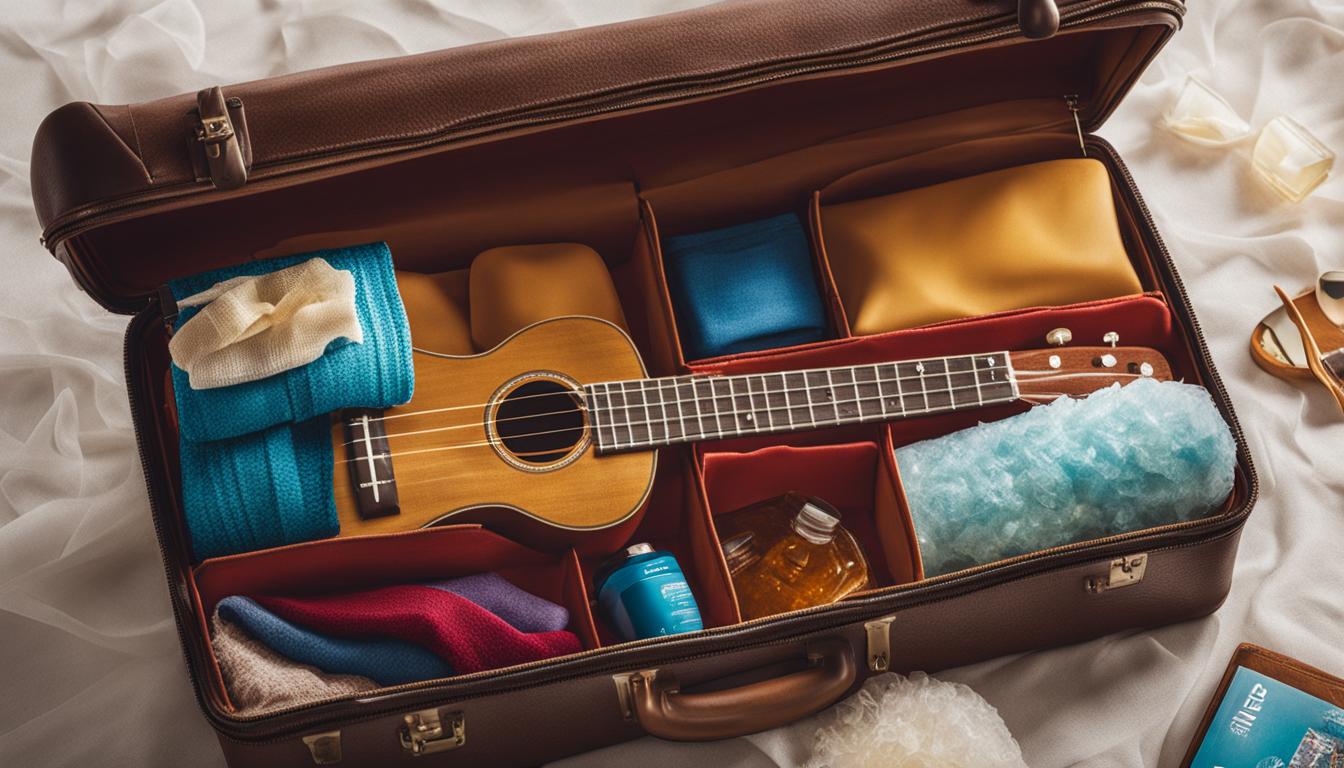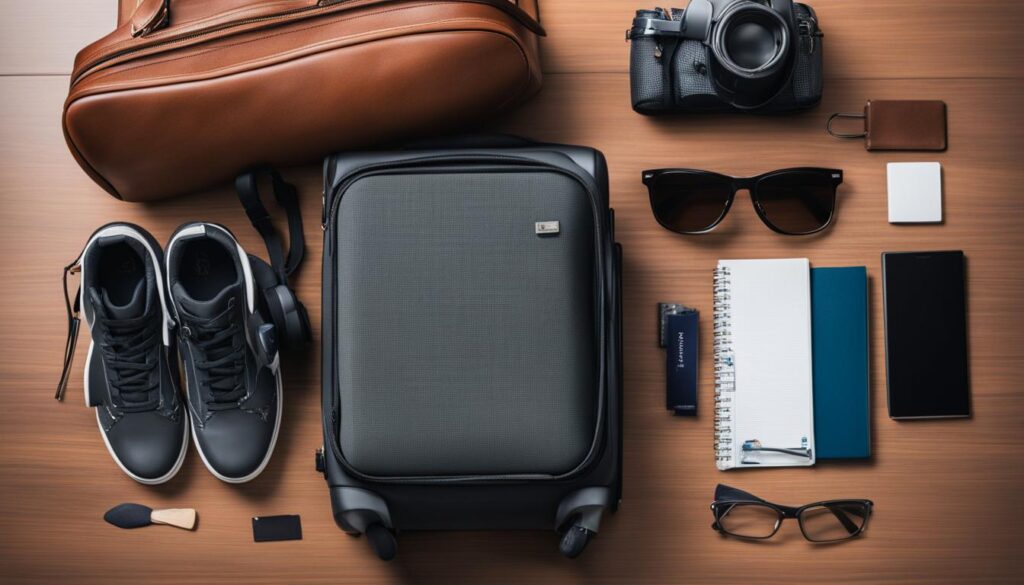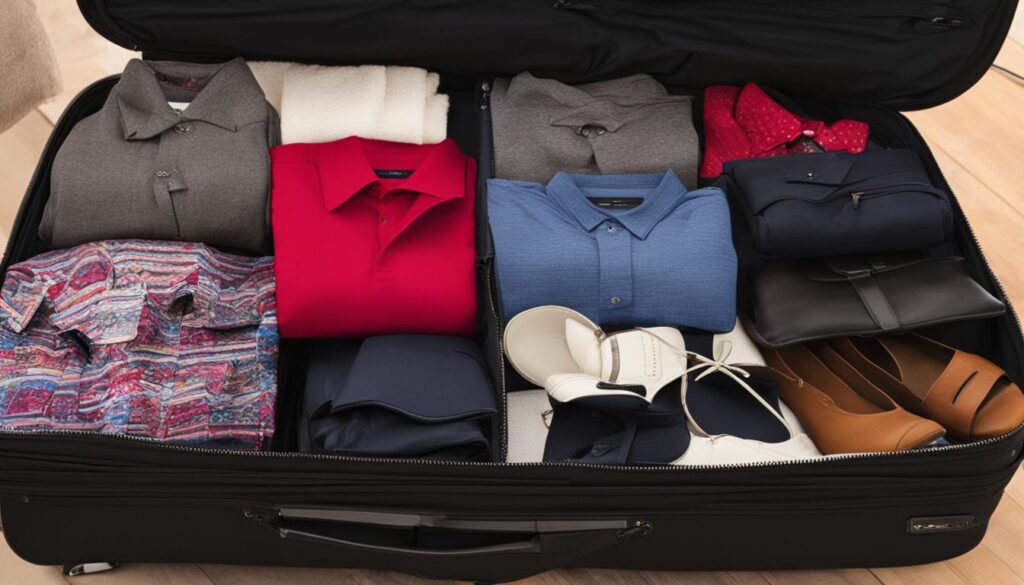When it comes to traveling with your ukulele, keeping it safe and secure is of the utmost importance. Knowing how to properly pack your uke in a suitcase can help prevent any potential damage during transit. Follow these uke packing tips and tricks to ensure that your beloved instrument arrives at your destination in perfect condition.
Key Takeaways:
- Choose a sturdy suitcase that provides adequate padding and protection for your ukulele.
- Invest in a gig bag or hard case designed specifically for ukuleles to offer additional cushioning and security.
- Loosen the strings of your ukulele to relieve tension on the neck and prevent any damage.
- Wrap your ukulele in bubble wrap or soft padding to provide an extra layer of protection.
- Secure the ukulele in the case using straps or padding to prevent any movement during transit.
Choose a Sturdy Suitcase
When it comes to packing your ukulele for travel, selecting the right suitcase is crucial for ensuring its safety. Look for a sturdy suitcase that provides ample protection and padding for your instrument. Consider opting for a hardshell case or a soft case with sufficient padding to shield your ukulele from any potential bumps or mishandling during transportation.
A hardshell case offers a higher level of protection, especially if you’re planning to check in your suitcase. It provides a rigid exterior that can withstand the rigors of travel. Additionally, the interior of a hard case is typically lined with soft materials such as plush velvet or foam, which help cushion and secure your ukulele.
If you prefer a soft case, make sure it is well-padded and designed specifically for ukuleles. Look for cases with thick foam padding, reinforced corners, and sturdy zippers. These features will help protect your ukulele from any potential impacts or pressure while on the move.
Table: Comparison of Suitcase Types
| Suitcase Type | Advantages | Disadvantages |
|---|---|---|
| Hardshell Case | Durable and provides excellent protection Interior padding prevents instrument movement Secure latches or locks |
Heavier and bulkier than soft cases May not fit in overhead compartments |
| Soft Case | Lightweight and easy to carry Often more affordable Flexible and can fit in various spaces |
Less protection compared to hard cases May not withstand rough handling |
Remember, the safety of your ukulele during travel largely depends on the quality and resilience of your suitcase. Investing in a sturdy and well-designed case will give you peace of mind that your beloved instrument is well-protected throughout the journey.
Use a Gig Bag or Hard Case
When it comes to safely packing your ukulele for air travel or any other journey, investing in a gig bag or hard case is crucial. These specially designed cases offer added protection and cushioning to keep your instrument safe and sound throughout your travels.
A gig bag is a lightweight and convenient option, perfect for short trips or when you need to carry your ukulele on your back. It typically features padded straps for comfortable transportation and multiple pockets for storing accessories.
If you’re looking for maximum protection, a hard case is your best bet. These cases are made from sturdy materials like ABS plastic or fiberglass, providing excellent resistance against impacts, bumps, and drops. Most hard cases also feature a plush interior lining to protect the ukulele’s finish and prevent any scratches.
Whether you opt for a gig bag or a hard case, make sure it is the appropriate size for your ukulele. A well-fitting case will prevent any unnecessary movement of your instrument and offer the best possible protection during transit.
Table: Comparison between Gig Bag and Hard Case
| Features | Gig Bag | Hard Case |
|---|---|---|
| Weight | Lightweight | Heavier |
| Portability | Easily carried on the back | May require a handle or wheels |
| Protection | Basic cushioning | Strong resistance to impacts |
| Storage | Multiple pockets for accessories | Single compartment |
| Price | Affordable | Higher cost |
Choose the option that best suits your needs and travel requirements. With a gig bag or hard case, you can have peace of mind knowing that your ukulele is well-protected and ready for any adventure.
Tips for Safely Packing a Ukulele in a Suitcase
When it comes to traveling with your ukulele, taking proper precautions to protect your instrument is essential. Here are some useful tips for safely packing your ukulele in a suitcase for a trip:
Loosen the Strings
Before packing your ukulele, it’s important to loosen the strings slightly. This helps relieve tension on the neck and prevents any potential damage, such as warping or snapping. Loosening the strings ensures that your ukulele remains in optimal condition during transit.
Use Bubble Wrap or Soft Padding
To provide an extra layer of protection, wrap your ukulele in bubble wrap or soft padding. Pay special attention to the neck, body, and headstock, as these are the most vulnerable areas. This will help safeguard your ukulele from scratches, dents, and other potential damage.
Secure the Ukulele in the Case
When placing your ukulele in the case, make sure it fits snugly and doesn’t move around. Use straps or additional padding to secure the instrument and prevent any shifting or jostling during travel. This extra measure will help keep your ukulele safe and secure.
Label the Suitcase as Fragile
Don’t forget to clearly label your suitcase as fragile. This will bring attention to the delicate nature of your instrument and prompt baggage handlers and fellow travelers to handle it with care. By indicating the fragility of your ukulele, you increase the likelihood of a safe and unharmed arrival.
| Tips for Safely Packing a Ukulele in a Suitcase | |
|---|---|
| Loosen the Strings | Before packing, loosen the strings slightly to relieve tension and prevent damage. |
| Use Bubble Wrap or Soft Padding | Wrap your ukulele in bubble wrap or soft padding to protect it from scratches and dents. |
| Secure the Ukulele in the Case | Ensure the ukulele fits snugly in the case and use straps or additional padding to prevent movement. |
| Label the Suitcase as Fragile | Clearly mark your suitcase as fragile to ensure careful handling during transit. |
Use Bubble Wrap or Soft Padding
When packing your ukulele in a suitcase, it’s crucial to provide adequate protection to prevent any scratches, dents, or other damage. One effective method is to use bubble wrap or soft padding to create a layer of cushioning around your instrument.
Focus on wrapping the vulnerable areas of your ukulele, such as the neck, body, and headstock, with bubble wrap or soft padding. This extra layer of protection will help absorb any impact during transit and keep your ukulele safe and secure.
Additionally, consider using cloth or foam padding to separate the different parts of your ukulele and avoid any potential collisions between them. This will further minimize the risk of damage and ensure that your instrument arrives in pristine condition.
| Advantages of Using Bubble Wrap or Soft Padding: | Disadvantages of Using Bubble Wrap or Soft Padding: |
|---|---|
|
|
“Using bubble wrap or soft padding is a smart way to protect your ukulele during travel. The cushioning provided by these materials helps absorb any shocks or impacts, keeping your instrument safe from harm. Take the time to wrap your ukulele properly, paying attention to the delicate parts, and enjoy peace of mind knowing that it is well-protected in your suitcase.”
Summary:
Using bubble wrap or soft padding is a recommended method for packing your ukulele in a suitcase. It offers excellent cushioning and protection against scratches and dents. Although it may take up some space in your suitcase and requires additional packing materials, the benefits of using bubble wrap or soft padding outweigh the disadvantages. Wrap your ukulele carefully, paying close attention to the vulnerable areas, and rest assured that your instrument will arrive at its destination unscathed.
| Advantages | Disadvantages |
|---|---|
|
|
Secure the Ukulele in the Case
Now that you have carefully wrapped your ukulele in bubble wrap or soft padding, it’s time to secure it inside the case. This step is crucial to prevent any shifting or jostling during transit. You want to ensure that your ukulele remains snug and immobile throughout the journey.
Start by placing your ukulele in the case, making sure it fits comfortably and there is no excess space. If there is any room left, use straps or additional padding to fill the gaps and hold the instrument firmly in place. The idea here is to minimize any movement that could potentially lead to damage.
By securing the ukulele in the case, you provide an extra layer of protection and minimize the risk of any accidents during travel. It’s worth investing a few extra minutes in this step to ensure that your instrument arrives at your destination intact and ready to be played.
Now that your ukulele is securely in the case, you can move on to the next step – packing the case properly in your suitcase.
Pack the Case in the Center of the Suitcase
When it comes to safely packing your ukulele for air travel, one important tip is to position the ukulele case in the center of your suitcase. By doing this, you can help distribute the weight evenly and minimize the chances of any undue pressure or stress on the instrument during transit.
Not only does placing the case in the center of the suitcase provide better balance, but it also reduces the risk of the ukulele shifting or jostling during the journey. This added stability can go a long way in ensuring that your beloved instrument stays safe and protected throughout the trip.
To further secure the ukulele in the suitcase, you can also use straps or additional padding to hold it in place. By taking these extra precautions, you can significantly reduce the risk of any potential damage that could occur during handling or turbulence.
“Placing the ukulele case in the center of the suitcase is a simple yet effective technique for safeguarding your instrument during air travel. It helps distribute the weight evenly and ensures that your ukulele remains secure throughout the journey.”
| Benefits of Packing in the Center | Tips for Secure Packing |
|---|---|
|
|
By following these safe ukulele packing techniques and placing the case in the center of the suitcase, you can provide optimal protection for your instrument and enjoy your travels without worrying about any potential damage.
Fill the Empty Spaces
When packing your ukulele in a suitcase, it’s important to make the most of the available space to ensure its safety. Utilizing any empty spaces in your suitcase can provide additional cushioning and support for your instrument. Here are some tips on how to fill the empty spaces effectively:
- Use soft items: Opt for soft items like clothing or towels to fill the empty spaces in your suitcase. These items will add an extra layer of padding and help protect your ukulele from any potential impacts during transit.
- Roll instead of folding: When packing your clothing, consider rolling them instead of folding to save space. Rolled clothing can be tucked into the gaps around your ukulele, providing additional padding and protection.
- Separate fragile items: If you’re carrying other fragile items along with your ukulele, make sure to separate them using soft materials like clothing or bubble wrap. This will prevent any potential damage caused by items shifting and bumping into each other.
By filling the empty spaces with soft items and separating fragile belongings, you can create a protective barrier around your ukulele, minimizing the risk of any damage during travel.
“Filling the empty spaces in your suitcase with soft items not only maximizes space efficiency but also enhances the protection for your ukulele.” – Packing Expert
Note: Avoid overpacking your suitcase as it may result in excessive pressure on your ukulele and could lead to potential damage. Ensure that the suitcase is securely closed and properly sealed.
| Soft Items | Pros | Cons |
|---|---|---|
| Clothing | Provides cushioning and protection | May take up more space |
| Towels | Soft and absorbent | May be bulky |
| Bubble Wrap | Extra layer of protection | May not fit in all spaces |
By using soft items strategically, you can ensure that your ukulele is surrounded by a layer of cushioning and securely packed within your suitcase. Remember, a well-packed ukulele is a protected ukulele!
Label the Suitcase as Fragile
When it comes to packing your ukulele for a trip, one important step is to clearly label your suitcase as fragile. This simple action can help ensure that your instrument is handled with care throughout its journey. By alerting baggage handlers and fellow travelers to the delicate nature of your ukulele, you increase the chances of it arriving at your destination unharmed.
Using a bold and legible label, prominently place the word “Fragile” on your suitcase. You can use stickers, luggage tags, or even write it directly on the surface. Make sure the label is clearly visible and not obstructed by other items or decorations on your luggage.
By labeling your suitcase as fragile, you send a clear message to those handling your baggage. It serves as a gentle reminder that there is something delicate and valuable inside that requires special attention. While it may not guarantee a completely smooth journey, it certainly increases the likelihood that your ukulele will be treated with the care it deserves.
Check the Ukulele upon Arrival
After a long journey, it’s important to carefully inspect your ukulele for any signs of damage upon reaching your destination. Take the time to check the instrument and ensure that it is still in proper condition before playing or storing it. Here are some steps to follow:
Step 1: Examine the Exterior
Start by examining the exterior of the ukulele. Look for any scratches, dents, or cracks on the body, neck, and headstock. Pay close attention to the edges and corners, as they are more prone to damage during travel.
Step 2: Check the Strings
Next, check the strings for any signs of wear or breakage. Gently pluck each string and listen for any buzzing or unusual sounds. Ensure that the strings are properly seated in the bridge and tuning pegs.
Step 3: Inspect the Neck and Fretboard
Carefully examine the neck and fretboard for any warping or separation. Run your fingers along the frets to feel for any sharp edges or raised spots. Make sure that the neck is straight and aligned with the body of the ukulele.
Step 4: Test the Sound
Lastly, play the ukulele to test its sound quality. Strum each string and listen for any buzzing, muted tones, or uneven volume. If anything sounds off, it may indicate a problem with the instrument that needs to be addressed.
By following these steps, you can ensure that your ukulele is in optimal condition and ready to be enjoyed at your destination. Remember, it’s better to address any issues early on rather than risk further damage by playing a compromised instrument.
| Step | Actions |
|---|---|
| Step 1 | Examine the exterior for scratches, dents, and cracks |
| Step 2 | Check the strings for wear or breakage |
| Step 3 | Inspect the neck and fretboard for warping or separation |
| Step 4 | Test the sound by playing the ukulele |
Conclusion
After reading this article, you are now equipped with the knowledge and tips to safely pack your ukulele in a suitcase for all your travels. Remember, the key is to prioritize protection and proper padding to prevent any damage to your beloved instrument.
Start by choosing a sturdy suitcase that offers sufficient padding and protection. Opt for a gig bag or a hard case specifically designed for ukuleles to provide added cushioning during transit.
Loosening the strings and wrapping your ukulele in bubble wrap or soft padding will further safeguard it from scratches or dents. Make sure to secure the instrument in the case to prevent any shifting or jostling.
Don’t forget to label your suitcase as fragile and check your ukulele upon arrival for any signs of damage. By following these safe ukulele packing techniques and uke packing tips, you can travel worry-free and enjoy making music wherever you go. Happy travels with your ukulele!
FAQ
How do I choose a suitcase for packing my ukulele?
Select a durable suitcase with enough padding and protection for your ukulele. Consider a hardshell or well-padded soft case for optimal safety.
Should I use a gig bag or a hard case for my ukulele?
Yes, investing in a gig bag or hard case specifically designed for ukuleles offers added protection and cushioning, especially during air travel.
Do I need to loosen the strings before packing my ukulele?
Yes, loosening the strings slightly helps relieve tension on the neck and prevents potential damage such as warping or snapping of the strings.
What should I use to wrap my ukulele for extra protection?
Wrap your ukulele in bubble wrap or soft padding, focusing on the neck, body, and headstock to prevent scratches or dents during travel.
How do I secure the ukulele in the case?
Make sure the ukulele fits snugly in the case and use straps or padding to hold it in place, preventing any shifting or jostling during transit.
Where should I place the ukulele case in the suitcase?
Position the ukulele case in the center of your suitcase to distribute weight evenly, avoiding undue pressure or stress on the instrument during transit.
Can I use empty spaces in my suitcase to provide extra cushioning?
Yes, fill any empty spaces with soft items like clothing or towels to provide additional cushioning and support for your ukulele.
Should I label my suitcase as fragile when traveling with a ukulele?
Yes, clearly mark your suitcase as fragile to alert baggage handlers and fellow travelers to handle it with care, ensuring the safe arrival of your ukulele.
What should I do when I reach my destination to ensure my ukulele is undamaged?
Upon arrival, check your ukulele for any signs of damage. Inspect the instrument carefully to ensure it is still in proper condition before playing or storing it.




